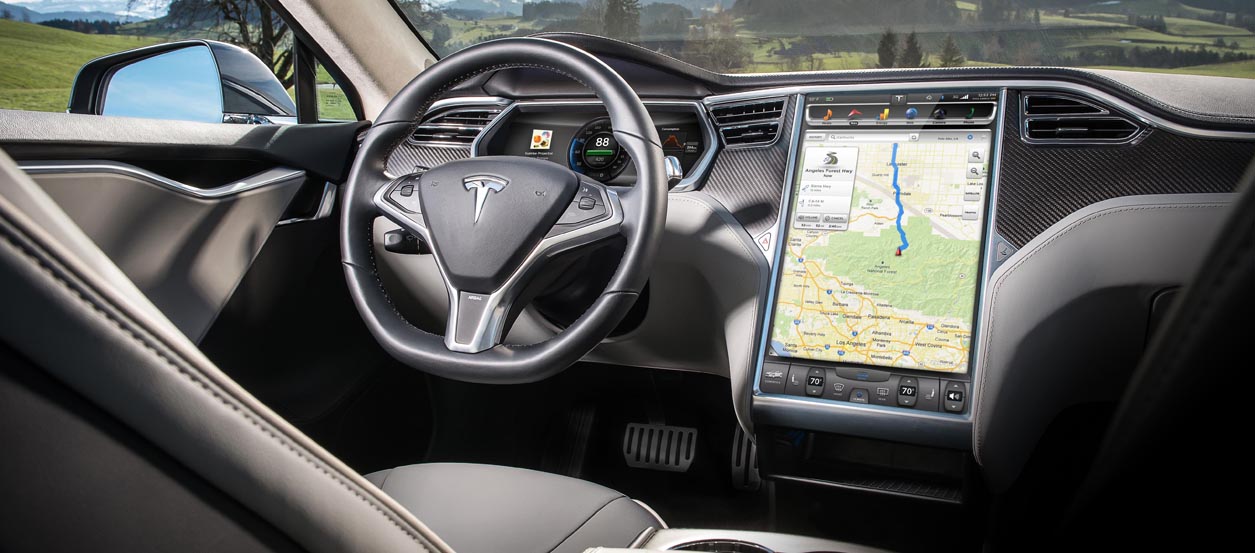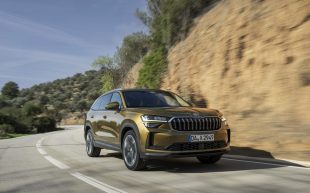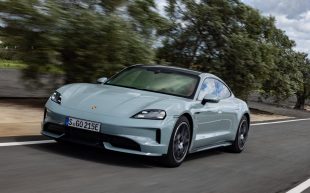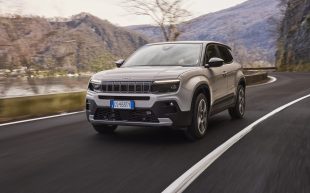First drive review: Tesla Model S Performance (2013)
California Dreaming? No, this is the real electric McCoy
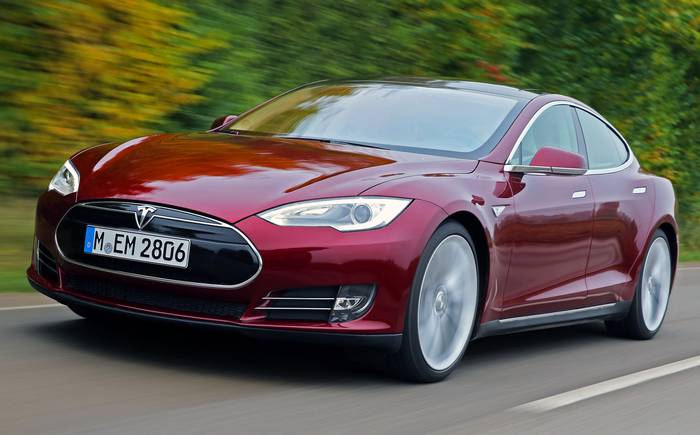
IT’S A SUNNY Californian morning and I am speeding north along the Pacific Coast Highway, dodging the salty spray as it kicks up over the road. The local radio station is playing Bruce Springsteen’s Johnny 99, about a closed-down car plant in Mahwah, New Jersey, and from behind the wheel of the Tesla Model S it suddenly seems appropriate.
This electric vehicle was assembled in Fremont, California, in one of the world’s biggest car factories. When General Motors, one of the plant’s co-owners, went bust in 2009, it shut down and was brought back to life only when Elon Musk, the founder of Tesla, picked it up for a mere $42m (£26m). He claims that old-style car makers are finished, and his battery-powered vehicle is the future.
The vision he’s promising is one of electric cars that are as fast as — or faster than — conventional ones, pollution-free (if you use green electricity) and free to refuel (if you use Tesla’s charging stations).
I back off the power, let the Model S coast and replenish the battery via the energy recovery system. Apart from the wind noise and radio, the car is silent. To look at, it could have come from Aston Martin’s studios — low-slung, muscular and neat, with a generous boot that houses two folding seats, giving it a carrying capacity of seven.
As for its performance, it’s faster to 60mph than a Porsche 911 Carrera. From standstill to 30mph it’s even more impressive — 1.7 seconds, according to the Dynolicious performance-testing app. That makes it possibly the quickest thing on four wheels this side of a Bugatti Veyron.
But that’s not all: it is also perhaps the most important electric car yet made. The Model S represents the last throw of the electric dice for — if this vehicle can’t persuade people to ditch petrol and switch to battery power, no car can.
In Britain electric vehicles account for less than 0.1% of car sales. Tens of millions of pounds spent on publicity and charging points, plus zero vehicle excise duty and London congestion charge and dedicated — often free — parking, have failed to energise sales.
The reason is simple: as the American chat-show host and car fanatic Jay Leno once succinctly put it: for a new technology to succeed, it needs to be better than what already exists — and so far electric cars aren’t. And they haven’t been since the Baker Electric in Leno’s garage was built in 1909, boasting a range of more than 100 miles — as great as that of most modern electric cars.
Musk hopes to change that. His first attempt was the Tesla Roadster, which had a mixed reception. The actor and car nut George Clooney cursed it for what he saw as its unreliability, and the company unsuccessfully went to court against Top Gear for criticising its shortcomings.
With the Model S, though, the company has sorted out many of the early problems. The Performance version has a range of 260 miles or more and takes just 20 minutes for a recharge sufficient to take it 130 miles — or two hours’ driving at the typical speed limit of 65mph on California’s freeways. The company is gambling that after two hours most drivers will be happy to stop for a 20-minute break, particularly as the charging stations are usually next to diners.
The car’s performance, and the fact that at Tesla’s charging stations the electricity is free, means the balance of cost and convenience has shifted in favour of the company’s battery-powered vehicles for the first time, it says.
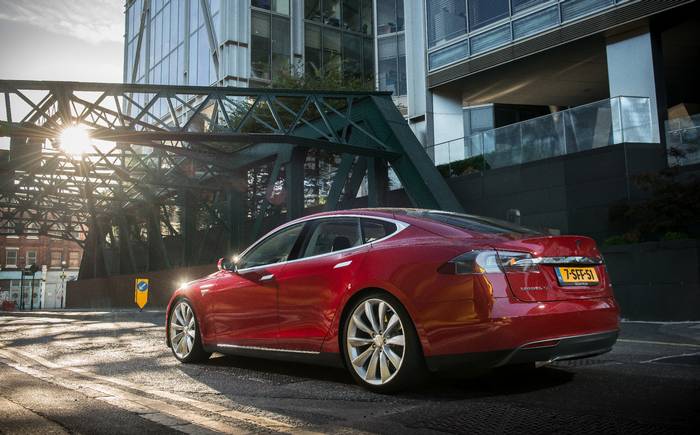
Deliveries of the Model S to British customers are due to start in March, by when Tesla says it will have begun work on a network of fast-charging stations, enabling drivers to recharge quickly — and free — along supercharging corridors that will eventually span Britain. Such electric highways already exist in California, where last year the Model S was the third-bestselling luxury car behind the Mercedes E-class and the BMW 5-series. So how well does it work?
My journey will take me 450 miles up the Californian coast, starting in Hawthorne, a suburb of Los Angeles where Musk’s SpaceX company builds space rockets, and ending in Palo Alto, Tesla’s headquarters in the heart of Silicon Valley.
His Model S is suitably hi-tech. The dashboard is dominated by a touchscreen that allows you to surf the web, plot routes using Google Maps, see satellite images of your location and destination and control everything, from the vehicle’s climate to its sunroof, with a swipe of the finger. The audio system is voice-activated, as is the navigation system (saying, “Navigate Starbucks”, for example, takes you to the nearest branch of the coffee chain).
But the real surprise about the Model S, gadgets aside, is how normal it feels to drive. Despite the huge investments that conventional motor companies have put into building electric cars, most of them feel like milk floats to drive. The Model S leads you quickly to conclude that other manufacturers haven’t been trying.
Everything from the door handles – which pop out, so you can pull open the doors only when you walk up to the car with the remote in hand – to the touch-sensitive controls feels cutting edge. The suspension copes with America’s famously under-maintained concrete freeways with ease, offering a Mercedes-smooth ride. So quiet is the electric motor that it makes 100mph (er, where legal) seem like 50mph.
This year Musk aims to produce 20,000 cars. Demand for the Model S has been helped by endorsement from the respected US test magazine Consumer Reports, which gave the car its highest rating yet — 99 out of 100 — for customer satisfaction. To allay fears about battery fade, Tesla offers an eight-year warranty against battery deterioration or malfunction.
There are downsides. One is cost. The Model S I drove was a tad more than $100,000 (or £80,000 if you buy it in the UK), though you can get a base model with a shorter range for about £50,000 (before a £5,000 government plug-in car grant). It’s heavy — a 2,100kg kerb weight compared with 1,990kg for the Aston Martin Rapide S, for example, and questions have been raised about its claimed range.
The New York Times reporter John Broder drove a Model S from Washington to New York. He described calling a tow truck to finish his journey after running out of charge and concluded that the car didn’t live up to Tesla’s claims about its range and abilities. “If this is Tesla’s vision of long-distance travel in America’s future . . . it needs some work,” he wrote.
Musk came out fighting and pointed to what he said were numerous errors in the report. The paper later seemed to back down and accept that the story was wrong in parts.
More recently a string of stories have suggested that Teslas were fire-prone, on the basis that three Model S cars were engulfed by fire after their batteries were punctured by debris in the road. Again, Musk put up a stout defence, producing statistics showing that his cars were less fire-prone than conventionally fuelled cars, and indeed that the occupants of the fire-damaged Teslas had walked away from the accidents without injury. The incidents have not affected the car’s five-star safety rating from the US government’s transport watchdog.
But as every electric car maker knows, the vehicle is only one side of the equation: the recharging infrastructure is just as important. Musk has installed a network of “supercharger” stations all the way up the California coast — and similar ones in Oregon and Washington state — to provide enough electric refills to take you from Mexico to the Canadian border without paying for fuel. An east-west coast-to-coast electric highway is almost complete.
The charging points I tried worked well. Buellton, home to the nearest supercharger, gave me a 100-mile charge in less than 15 minutes.
The procedure is simple enough: you pull in, open the recharging flap — in the same place you’d expect to find the fuel cap — and plug in the electric “hose”, which feels much like a fuel hose. As the batteries replenish, the available range appears on the dash. You can wander off to get a coffee and the refuelling hose locks in place until you return and unlock the car.
I recharged again at Atascadero, further up Route 101, and then at Gilroy. It would have been easy to get all the way to Palo Alto on just three quick recharges, taking no more time than I would normally have spent on coffee stops on a 450-mile trip.
But there’s another way to recharge, and that’s with the help of PlugShare, an app that gives you a map showing your position and your proximity to “good Samaritans” — folk who are happy to let you use their home recharging stations.
Again, it’s free — those who enrol with PlugShare are usually electric car owners and passionate enough about the technology to let total strangers such as me drop in and charge up without payment.
About 93 miles later I consult the app and after a quick exchange of text messages call on Ben Weiss in Carpinteria, about 10 miles from Santa Barbara. He’s a Tesla owner who tells me he supports the kind of “disruptive technology” that Musk is using to challenge the dominance of the motor industry.
About 10 minutes from Santa Cruz, at Aptos, another good Samaritan, Patricia Kelly, offers me a free recharge and explains how the fast-growing community of Tesla owners look after one another through car clubs, mutual recharging and internet forums.
“We believe in the technology, not because it’s fashionable but because it’s convenient. People who buy the Model S are happy with it and stick with it. If there were problems, you’d soon hear about it on the internet. That says all that needs to be said.”
So does the Model S meet Leno’s criterion of being better than the existing technology? It’s faster and smoother than almost anything I’ve driven. Recharging is not as quick as its fossil-fuel equivalent, and the 260-mile range, while beating that of most other electric cars hands down, can’t match the 700 miles or more that a full diesel tank can offer. But the electricity is free, a fact that is winning over drivers in America, where fuel is less than half the price it is in Europe.
When I finally reach Palo Alto, it’s with regret that I hand back the keys. The new BMW 4-series that I drive to the airport feels distinctly old-fashioned, and when I stop at lights, instead of birdsong I hear engine noise. Worst is the performance. It’s a quick car by most standards but compared with the Model S it takes time to gather pace.
Tesla hasn’t solved all the problems — the price alone makes its cars niche products — but given that the company is just over a decade old, it deserves credit for accomplishing what western governments have failed to do, despite pledges to reduce dependency on imported oil.
The real test will come when a much cheaper Tesla arrives in 2015 in the form of the “Model E” (the name is not confirmed). It is expected to sell for close to $35,000 — the critical price for mass-market acceptance. The price cut has been achieved, according to Musk, by advances in battery technology and production efficiency savings.
If it is as good as the Model S, it could change the way we drive. More than a century after Leno’s Baker Electric, the technology may finally achieve its potential — giving fossil-fuel cars a run for their money.
Tesla Model S (60 kWh)
Five-door luxury hatchback
Recharge time 6¾hr (via standard socket)
Range 240 miles (official)
Battery warranty Eight years/ 125,000 miles
Battery lease terms N/A
0-62mph 6.2sec
Power 302bhp
Top speed 120mph
Verdict Sumptuous, but beware the paucity of UK charging points
Rating 9/10
The Rivals
Statistics assembled by Nigel Powell
BMW i3
Five-door supermini
Recharge time 8-10hr (via standard socket)
Range 118 miles (official)
Battery warranty Eight years/100,000 miles
Battery lease terms N/A
0-62mph 7.2sec
Power 170bhp
Top speed 93mph
Price £25,680*
Verdict Fast, stylish and roomy city car with bags of character
Rating 7/10
Nissan Leaf
Five-door hatchback
Recharge time 10-12hr (via standard socket)
Range 124 miles (official)
Battery warranty Five years/60,000 miles
Battery lease terms £70 per month over three years/7,500miles per year
0-62mph 11.9sec
Power 109bhp
Top speed 90mph
Price £20,990* (Leaf Visia)
Verdict Roomy, fast workhorse that’s fun to drive
Rating 6/10
Renault Zoe
Five-door supermini
Recharge time 3-4hr (via free 7kW wall box)
Range 130 miles (official)
Battery warranty Unlimited but monthly hire fee applies
Battery lease terms From £70 per month over 3 years/7,500 miles per year
0-62mph 13.5sec
Power 90bhp
Top speed 84mph
Price £13,995*
Verdict Nimble urban runabout at a great price, but no regular socket option
Rating 7/10
Ford Focus EV
Five-door hatchback
Recharge time 7-10hr (via standard socket)
Range 100 miles (official)
Battery warranty Five years
0-62mph 11sec
Battery lease terms N/A
Power 143bhp
Top speed 85mph
Price £28,580*
Verdict Comfortable saloon, but boot space suffers from electric conversion
Rating 7/10
Volkswagen e-UP!
Five-door supermini
Recharge time 9hr (via standard socket)
Range 93 miles (official)
Battery warranty Eight years/100,000 miles
Battery lease terms N/A
0-62mph 12.4sec
Power 81bhp
Top speed 81mph
Price £19,250*
Verdict Typically stylish German technology in a city-friendly package
Rating 7/10
*After government grant


